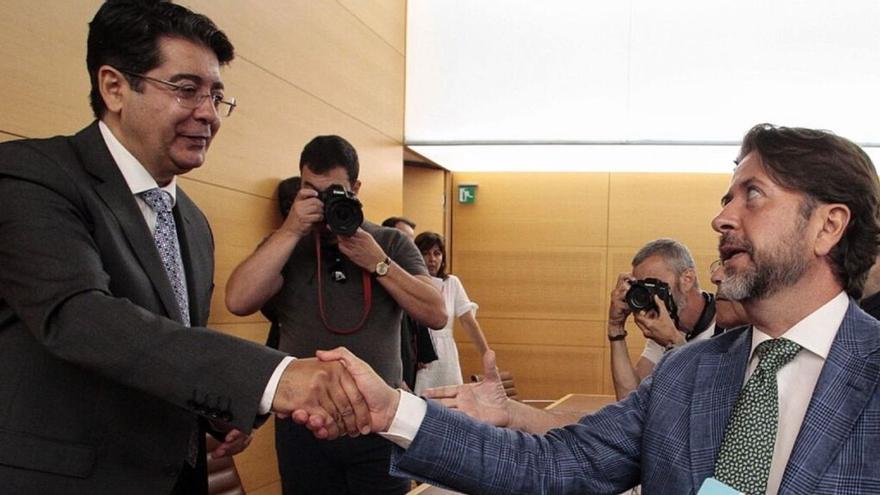
The Budget of the Island Council of Tenerife of the next year It will multiply by almost sixteen the amount of subsidies that were awarded directly to municipalities in 2019, without taking into account the territorial equity and the investment per inhabitant and municipality or region that the Strategic Framework for Insular Development (MEDI) seeks, which was approved in 2016 and which set its roadmap in two five-year periods (2016-2021 and 2021 -2025).
The island government opts for the nominative subsidy to distribute almost 16 million euros that go to nine socialist municipalities, four nationalist and one in the hands of the PP. The greatest imbalance refers to the contribution itself, since 80 percent of the money is distributed to the municipalities where the mayor is a party partner of the president of the Tenerife Council, a calculation that rises to 88% if municipalities are included where the PSOE integrates the local government with other political formations.
Facing the objective of Strategic Framework for Island Development, which sought in its approval a more cohesive society by supporting the municipalities with fewer resources –which goes hand in hand with less population–, the approval of the subsidies to finger causes a greater imbalance between localities. As an example, Vilaflor will receive almost a thousand euros per inhabitant, more than twice what they had planned in the regulated budget (which increases by 975.75 euros), or Fasnia, with 375 euros more per inhabitant, which quadruples the initial forecast , something similar to what happens in El Tanque, (with +482 euros per inhabitant), while the contribution in San Juan de la Rambla (+268) and in La Victoria (+140) almost triples per neighbor, or La Slaughter, with 310 euros per inhabitant, double what it has received in the budgets to date.
Although the Insular Corporation has always ensured to boost the economy of the municipalities with fewer resources, La Laguna will receive in the 2022 Budgets a contribution of 1.5 million that reinforces its position over other localities with fewer residents.
The other face: more than half of the island’s population is left out of the distribution that is limited to fifteen municipalities which excludes San Miguel de Abona, Santa Cruz, Arona, Granadilla, Tacoronte, Santa Úrsula, Santiago del Teide or Puerto de la Cruz, among others.
Apart from the nominative subsidies that were presented last Thursday at the Insular Council of Territorial Administration (CIAT), and that caused the so-called rebellion of the non-socialist mayors, the investments of the Cabildo are marked in the Strategic Framework for Insular Development (MEDI ) that was approved in 2016, the roadmap that until recently could be consulted on the meditenerife.es website and that contemplated the execution of 36 programmed two periods of five years each: from 2016 to 2021 and 2021 to 2025.
In the first five years of the referred strategic framework, two stages are distinguished. The first, under the mandate of Carlos Alonso, which spans from 2016 to 2019, when his successor, Pedro Martín (PSOE) takes the baton to date. With the nationalists at the fore, the annual investment collected in the aforementioned strategic framework amounted to 120 million euros per year, compared to the 82 million allocated in the socialist stage.
Taking into account the investments made between 2016 and 2019 within the strategic framework of Insular Development, only one city council is of a nationalist sign, El Sauzal, with Mariano Pérez. For the rest, Vilaflor, El Tanque and Buenavista del Norte –of a socialist nature– monopolize the first three places in the annual investment ratio per inhabitant, which also includes the regional contribution. Behind the first three socialist municipalities that receive the most contribution per neighbor, La Guancha, Santiago del Teide and Puerto de la Cruz governed between 2016 and 2019 by the PP. They are followed by Fasnia and Los Silos, also from the PSOE, in eighth place El Sauzal, in the hands of CC, and San Juan de la Rambla, from the PSOE, which monopolize the top ten positions in the list that details the contribution to the 31 municipalities.
Puerto de la Cruz, although with more population, is among the most favored in the distribution of Alonso’s stage, taking into account the commitment acquired with the PP team led by Lope Afonso to contribute more than 33 million to the renovation of the tourist plant.
In general, lhe localities with fewer inhabitants were the most benefited in the distribution of the CC stage While those with the largest population, such as Santa Cruz de Tenerife, La Laguna and Arona have since remained at the bottom of the table due to the Cabildo’s objective of favoring municipalities with less margin for growth in their accounts.
Guía de Isora, who until 2019 governed the socialist Pedro MartinNor was it disadvantaged. In fact, it appears in the middle of the classification, above smaller towns such as Arico, Santa Úrsula, La Victoria or Tegueste, until the last elections in the hands of nationalists.















